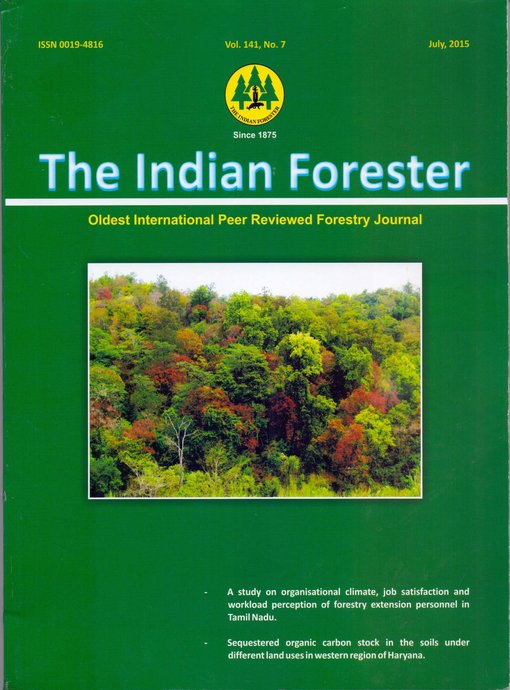A Quick Method to Assess Site Quality of Young Chir Pine Stands
DOI:
https://doi.org/10.36808/if/2015/v141i7/73931Keywords:
Chir Pine, Height Intercept, Internodal Length.Abstract
In the present study a quick method termed as 'Height Intercept Method' is used to determine site quality of any chir pine forests/stands. The study was conducted in Solan district of Himachal Pradesh (India) selecting eight chir pine sites viz., Oachghat, Sultanpur, Barog, Shilli, Bauhli, Kandaghat, Subathu and Dharampur) Height and Height Intercepts i.e. 3, 4, 5, 6 and 7th year mean internodal length for 19 years old trees were measured from breast height. Relationships between mean internodal lengths (height intercept) and height of trees were developed using linear, curvilinear, log linear and log curvilinear models. The results revealed that 6 years height intercept was reliable estimate to express the relationship between height of tree and height intercept of 19 years old chir pine stands and thereby the site quality. The best relationship between height and height intercept was: Height = 3.0493 + 0.1419 Height Intercept + 0.0007 Height Intercept2 . Height intercept varied from 30 to 70 cm. Chir pine in Dharampur site exhibited lowest height intercept thus expressing poor site quality whereas, chir pine in Oachghat was maximum height intercept thereby good site quality. The site quality as estimated by height intercept method were compared with standard site qualities given by Forest Research Institute of India (F.R.I.) for chir pine stands/forests and it was found that good site quality of present study was equivalent to site quality I/II and poor site quality equaled site quality III of F.R.I.References
Applegate G.B., Gilmour D.A. and Mohns B. (1989). Biomass and productivity estimations for community forest management: a case study from hills of Nepal - I, Biomass and productivity of Chir pine (Pinus roxburghii Sargent) plantations. Biomass, 17 (20): 115 - 137.
Beck D.E. (1971). Height growth patterns and site index of white pine in southern Appalachians. USDA Forest Service research Paper. SE-154: 6p.
Brown J.H. and Stires J.l. (1981). Growth intercept methods for predicting site index in red pine plantations in the Alleghemy plateau of Ohio.Northern Journal of applied Forestry, 7 (1): 27-30.
Dalai D., Gupta B., Gupta, N.K. and Sambhar O.P. (2000). Site quality assessment of young chir pine plantations. Journal of Tropical Forest Science, 12 (4): 650-655.
Day M.W., Bey C.F. and Rudolph V.J. (1960). Site index for planted red pine by the 5-year growth intercept method. Journal of Forestry, 58 (3): 198-202.
Ferree M.J., Shaerer T.D. and Stone E.L. (1958). A method of evaluating site quality in young red pine plantations. 1958. Journal of Forestry, 32 (4): 417- 428.
Gujrati D.N. (1988). Basic Econometrics. New Delhi, Mcgraw Hill Book Co. 705p.
Raina V. (1979). Forest and soil conservation in Himachal Pradesh. Fifth five year plan and its progress. In: Man and Forest proceedings. K. M.Gupta and Desh bandhu (ed.).
Satoo T. (1971). Primary production relations of coniferous forest of Japan. In: Proc. Brussels symposium on productivity of Forest Ecosystems. Duvigneaud, P. (ed.) UNESCO, Paris. pp 191-205.
Smith J.H.G. and Ker J.W. (1956). Some problems and approaches in classification of site in juvenile stands of Douglas Fir. Forest Chronicle, 32 (4): 417-428.
Wakeley P.C. and Marrero J. (1958). Five-year intercept as site index in southern pine plantations. Journal of Forestry, 56 (5): 332-336.
Downloads
Downloads
Published
How to Cite
Issue
Section
License
Unless otherwise stated, copyright or similar rights in all materials presented on the site, including graphical images, are owned by Indian Forester.





